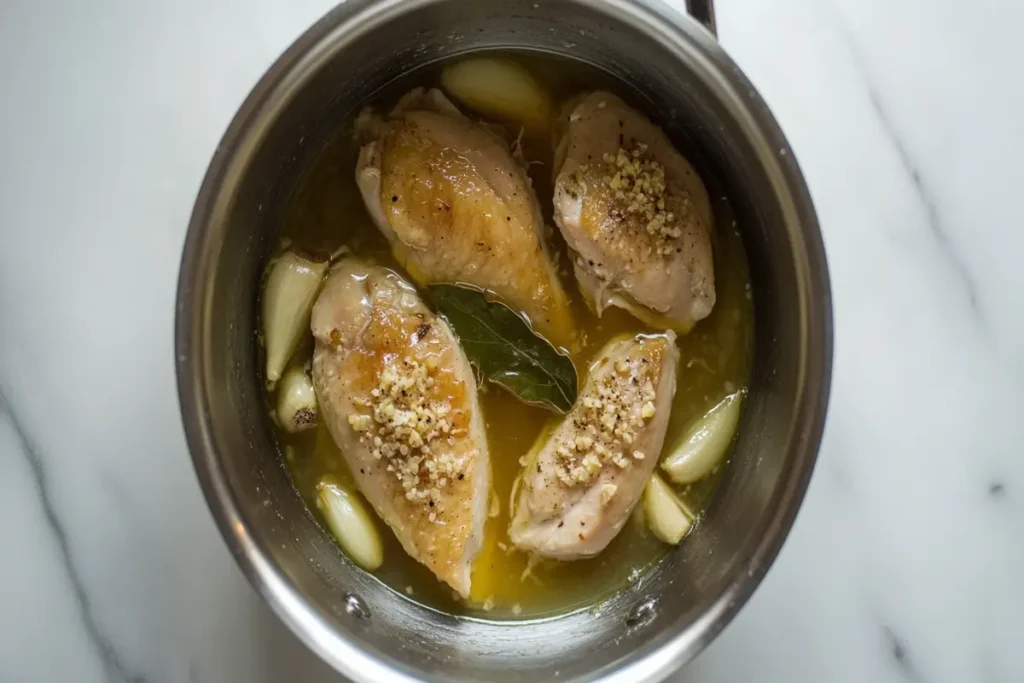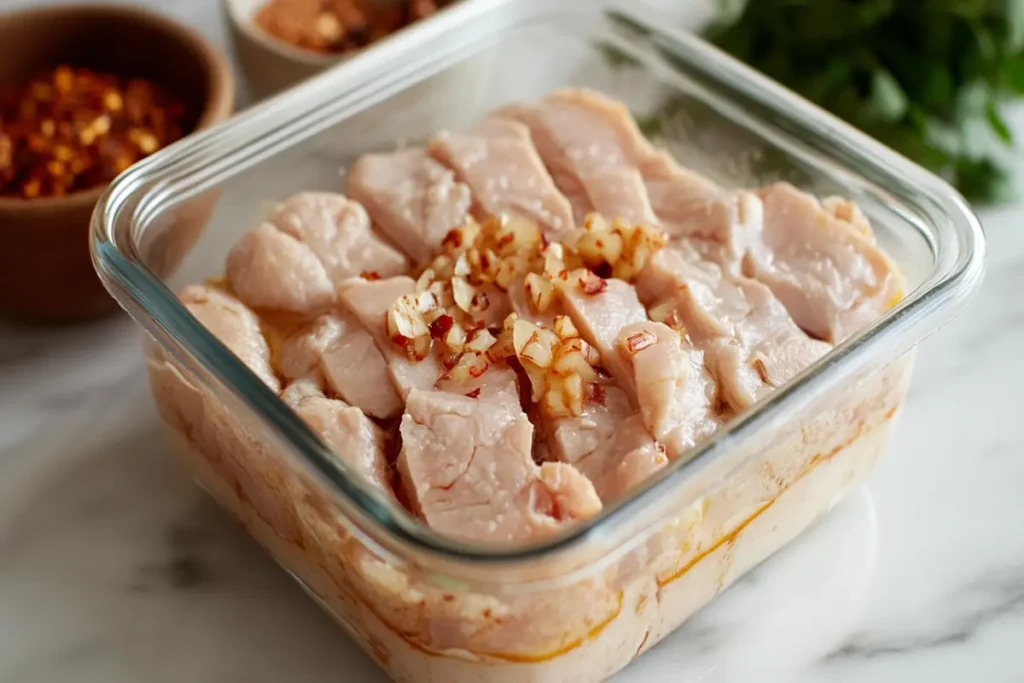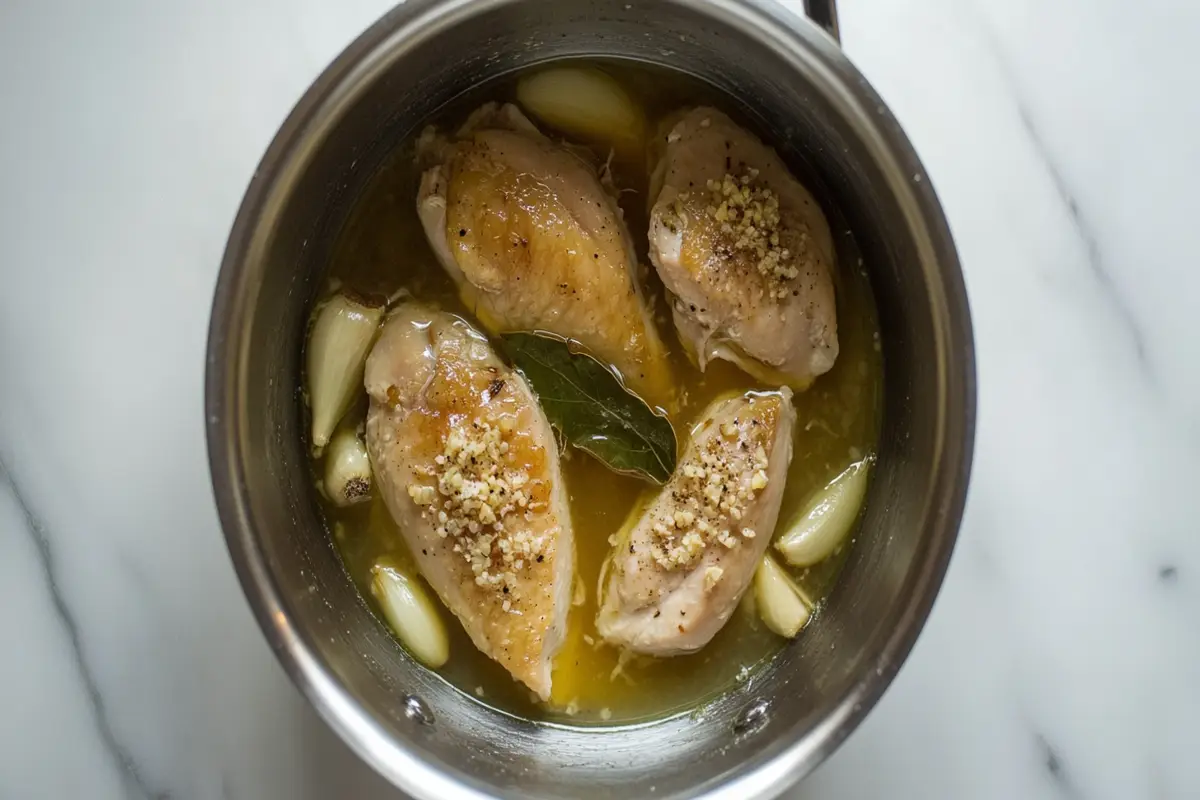Introduction
Poached chicken used to sound boring to me—like hospital food or one of those bland diet meals people only eat because they “have to.” But once I figured out how to make it the right way? Game. Changer. It’s tender, it’s juicy, and honestly, it’s one of the easiest ways to cook chicken that actually tastes good—without grease, without stress, and without any fancy kitchen tricks.
I’m Chris, and I’ve had my fair share of dry, overcooked chicken disasters. I’ve grilled it, baked it, pan-fried it—you name it. But poaching? That’s the method I keep coming back to. It’s low-maintenance, super healthy, and surprisingly packed with flavor if you build it right from the start.
So if you’re looking for a way to cook chicken that’s clean, simple, and totally stress-free, you’re in the right place. I’m gonna walk you through everything—no fancy tools, no hard-to-find ingredients. Just real talk, good food, and chicken that actually tastes like something you want to eat.
Why Poached Chicken Deserves a Spot in Your Weekly Meal Plan
The Healthier Choice That Doesn’t Compromise on Flavor
I won’t lie—I care about eating clean, but I still want my food to taste good. That’s where poached chicken nails it. It’s cooked in water or broth with herbs, garlic, and maybe a little citrus, which means it’s low in fat but still full of flavor. You don’t need butter or heavy sauces to make it work.
Back when I started trying to clean up my eating, poached chicken was my go-to. I could make a big batch on Sunday, and it kept me from reaching for takeout during the week. It’s not just healthy—it’s actually enjoyable, which, let’s be real, isn’t always the case with “healthy” food.
Ideal for Meal Preppers, Busy Parents, and Anyone with a Fork
I’ve got a full plate—work, family, trying to stay sane in between. So when a recipe helps me get dinner on the table without a mess or a meltdown? I’m all in. That’s exactly why I make poached chicken almost every week. It’s just so easy.
You toss it in a pot, bring it to a gentle simmer, and that’s it. No flipping, no oven babysitting, no stress. Then you’ve got perfectly cooked chicken for salads, bowls, sandwiches—whatever you need. It’s one of those small kitchen wins that makes everything else a little easier.
What Is Poached Chicken, Really?

If you’ve ever lumped poached chicken in with boiled chicken, hey, you’re not alone. I did the same thing at first. But once I figured out the difference, it totally changed how I cook. Poaching is all about gentle heat—it’s calm, controlled, and kind of foolproof once you get the hang of it.
Poaching vs Boiling: Nope, They’re Not the Same Thing
Here’s the deal—boiling chicken is like sending it through a hot water boot camp. The water’s rolling, bubbling, and honestly just way too intense for delicate meat like chicken breast. That’s why it ends up tough and stringy if you’re not watching it like a hawk.
Poaching, on the other hand, is more like giving your chicken a warm bath. The water (or broth) stays just below a simmer, somewhere around 160–180°F. That gentle heat cooks it evenly without shocking the meat, so you end up with chicken that’s juicy and tender—never dry or rubbery.
Think of it like this: boiling is aggressive, poaching is chill. And chill is what we want for soft, sliceable, juicy chicken.
The Science Behind That Tender, Juicy Texture
Okay, so quick nerd moment—but don’t worry, I’ll keep it short. When you cook chicken in lower temps, the proteins don’t seize up as fast. That means the muscle fibers stay soft, and the moisture stays inside the meat instead of getting squeezed out. That’s why poached chicken doesn’t need extra oil or sauces to be moist.
And if you flavor the liquid right—add some onion, garlic, bay leaf, or even a few peppercorns—you’re infusing that chicken with subtle flavor from the inside out. It’s like marinating while you cook, but without the wait.
Plus, the leftover poaching liquid? You better believe I save that stuff. It’s like instant broth, and it works great for soups, grains, or even as a base for sauces.
Basic Ingredients You’ll Need (No Fancy Stuff Here)
I like recipes that don’t send me on a wild goose chase through the grocery store. Poached chicken keeps it simple. If you’ve got chicken, water, and a few seasonings, you’re already halfway there. But I’ll show you a few extras that can boost the flavor without making things complicated.
Your Go-To Grocery List for Poaching Chicken
Here’s what I usually keep on hand:
- Chicken breasts or thighs – Boneless skinless breasts are the go-to for clean, lean meals. Thighs? Juicier and more forgiving if you’re not great at watching the clock.
- Water or broth – I’ll use low-sodium chicken broth when I want more flavor. Water works just fine, especially if you’re adding herbs and veggies.
- Garlic cloves – Smash a couple and toss them in. Instant flavor boost.
- Onion – Half an onion in the pot makes a big difference. Doesn’t have to be fancy—just peel and drop it in.
- Bay leaves – Adds a subtle, earthy flavor. I always keep some in the spice drawer.
- Salt and pepper – Start light; you can always season more later.
- Whole peppercorns – Not required, but they give that slightly peppery edge without being overpowering.
You don’t need to measure anything down to the grain. Just get those basics in the pot, and you’re set.
Optional Add-Ins to Amp Up the Flavor
If I’m feeling fancy—or if I’ve got a few odds and ends in the fridge—I’ll throw in:
- Celery or carrots – Chop ’em big and toss them in. They add depth to the broth and keep things from tasting too plain.
- Lemon slices – A few thin slices in the water can add just the right amount of brightness. Skip the juice—it can be too strong for poaching.
- Fresh herbs like thyme or parsley – Tie ’em with kitchen twine or just toss in a handful. Totally up to you.
None of this is mandatory. But if you want to impress your taste buds (or your family)? These little touches go a long way.
How to Poach Chicken the Right Way (With Zero Guesswork)
Poaching sounds fancy, but it’s honestly one of the easiest ways to cook chicken. You just need a pot, a lid, and a little patience. No splattering oil, no oven preheating, no thermometer drama if you follow these simple steps.
Step-by-Step Method for Stovetop Poaching

Here’s exactly how I do it at home:
- Pick your pot – Go with a saucepan or sauté pan that fits the chicken in a single layer. You don’t want them stacked or cramped.
- Add the chicken – Lay your chicken breasts or thighs flat in the pan.
- Pour in the liquid – Cover the chicken with water or broth. You want just enough to submerge it, not drown it.
- Add your seasonings – Toss in garlic, onion, bay leaf, a few peppercorns—whatever you like. Salt it lightly.
- Bring to a simmer—slowly – Put it on medium heat and keep an eye on it. You want small bubbles forming around the edges, not a rolling boil.
- Cover and reduce heat – Once it’s gently simmering, cover the pan and drop the heat to low. Let it hang out for about 10–14 minutes depending on thickness.
- Check for doneness – Cut into the thickest part. It should be white all the way through with clear juices. Or, if you’re using a thermometer, shoot for 165°F.
- Let it rest – Take the chicken out and let it sit for 5–10 minutes before slicing. It’ll stay juicy, promise.
Boneless or Bone-In? Let’s Talk Cuts

I use boneless skinless chicken breasts most of the time because they cook faster and shred easier. But thighs? Man, they’re so forgiving. Hard to overcook, packed with flavor, and a little fattier in a good way.
If you’ve got bone-in cuts, you can totally use them—just bump the cook time up a bit (closer to 18–20 minutes) and check with a thermometer to be sure.
How Long Should You Actually Cook It?
That part depends on two things—your cut and the size. Here’s a quick cheat sheet I use:
- Small breasts (thin or pounded): 8–10 minutes
- Regular chicken breasts: 12–14 minutes
- Thighs (boneless): 14–16 minutes
- Bone-in pieces: 18–22 minutes
Always check the center to be sure. Undercooked chicken is a no-go, but the beauty of poaching is—it’s really hard to mess up if you keep the heat gentle and the lid on.
Common Mistakes and How to Dodge Them
I’ve made every one of these at least once, so learn from me here:
- Cranking the heat – If you see a full boil, kill the heat. It’ll make the chicken tough fast.
- Not seasoning the liquid – Water alone works, but no flavor’s going in. Give it at least garlic, onion, and salt.
- Skipping the rest period – If you slice too soon, the juices spill out and you’re left with dry pieces.
Give it a few minutes to settle after cooking—it makes all the difference.
Kitchen Hacks to Make Poaching Faster and Easier
You know how some recipes sound simple, but end up taking forever? Yeah, poached chicken isn’t like that. And with a few smart moves, you can make the whole process even more efficient—especially if you’re cooking for the week ahead like I do.
My Sunday Meal Prep Routine (No Stress, I Promise)
Sunday afternoons used to stress me out. Now? I make a batch of poached chicken while I clean up the kitchen, fold some laundry, or catch up on whatever my kids left on the DVR. Here’s how I knock it out fast:
- Cook in bulk – I poach four to six chicken breasts at once. Just make sure they all fit in a single layer so they cook evenly.
- Strain and save the broth – Once I pull the chicken, I pour the leftover broth through a fine strainer into a jar. I use it later in soups, quinoa, or even to reheat rice without drying it out.
- Cool before slicing – This one’s key. I let the chicken cool down in the liquid for a few minutes if I’m not in a rush. It locks in the juices and keeps the meat super tender.
I portion it out into containers with different add-ins—like cooked grains, roasted veggies, or salad greens—so I’m not stuck eating the same bowl every day. Easy wins, all week long.
Tools That Make Life 10x Easier (Not Sponsored, Just Obsessed)
You don’t need any fancy gadgets to poach chicken. But if you want to make it almost too easy? These tools help a ton:
- Digital thermometer – This one changed everything for me. You stick it in the thickest part, and if it says 165°F, you’re golden.
- Wide sauté pan with a lid – I used to use a stock pot, but a wide, shallow pan helps cook more evenly and faster.
- Mesh strainer – Super handy for saving that broth without all the garlic skins and bay leaves floating around.
No need to drop money on new gear—but if you’ve got these lying around, you’re already ahead of the game.
Flavor Boosters That’ll Change the Game

Look, plain chicken is fine. But once you start layering in flavor from the poaching liquid and smart toppings? That’s when it goes from “meal prep chicken” to actually tasty dinner. These are the little things I toss in that don’t take extra time, but make a big difference.
Infusing the Broth with Fresh Herbs, Citrus, and More
You don’t need to go wild here. A few well-placed ingredients in the pot can totally level up your chicken.
- Fresh thyme or parsley stems – I just toss them in whole. They give the broth a subtle herbal depth.
- Lemon slices – Not too much—just a few thin slices. They add a brightness that makes the chicken feel fresh.
- Smashed garlic cloves – Three or four go in every time. Not overpowering, just flavorful.
- Ginger slices – Especially good if you’re planning on using the chicken in stir-fries or rice bowls.
It’s not about making soup here—it’s about infusing that water with enough character that the chicken picks it up while it poaches.
Using the Leftover Broth—Don’t Toss It!
Whatever you do, don’t pour that liquid gold down the drain. Once it cools, strain it and save it. I use it to:
- Cook rice or quinoa for a flavor boost.
- Start soups or stews during the week.
- Reheat chicken or veggies without drying them out.
I usually keep a jar of it in the fridge and freeze anything extra in ice cube trays. Sounds nerdy, but it saves time later.
What to Serve with Poached Chicken (Because Sides Matter)
Poached chicken’s like that one friend who gets along with everybody. It fits into any meal vibe—light and fresh, cozy and warm, spicy or simple. Here’s what I usually pair it with:
Low-Carb Favorites
When I’m keeping things light, these are my go-to combos:
- Zucchini noodles or cauliflower rice with a squeeze of lemon and some olive oil
- Roasted veggies like Brussels sprouts, carrots, or green beans
- Big green salads with crunchy cucumbers, cherry tomatoes, and a creamy dressing
Rice, Noodles, and Grain Bowl Ideas
Some nights, you just want comfort. These sides turn poached chicken into something hearty:
- Steamed jasmine rice with soy sauce and scallions
- Pasta or egg noodles tossed with olive oil and garlic
- Quinoa bowls with chickpeas, avocado, and a tahini drizzle
Whatever you’ve got on hand? Poached chicken probably works with it. That’s the beauty of it.
How to Store and Reheat Poached Chicken Without Drying It Out
Now that you’ve made the perfect batch, let’s not mess it up in the fridge or microwave. Trust me, dry reheated chicken is the worst.
Fridge and Freezer Storage Tips
Here’s how I keep mine fresh:
- Fridge: Store in an airtight container with a little bit of the poaching liquid. Keeps it moist for 4–5 days.
- Freezer: Slice or shred before freezing. I pack it into freezer bags in single portions with a spoonful of broth. Lasts 2–3 months easy.
Best Reheating Methods (Microwave? Air Fryer? Let’s Break It Down)
- Microwave: Add a splash of broth or water, cover with a damp paper towel, and heat in 30-second bursts. It’s fast and keeps things juicy.
- Skillet: Heat gently in a nonstick pan with a splash of broth or olive oil.
- Steam: If you’ve got a steamer basket, even better. It keeps everything soft and moist.
Avoid the oven unless you’re baking it into something. Otherwise, it’ll dry out fast.
Creative Ways to Use Leftover Poached Chicken
Leftovers are never boring when you’ve got poached chicken in the fridge. Here’s how I keep it exciting through the week.
Chicken Salad, Wraps, and More Lazy-Genius Meals
I throw it into:
- Greek yogurt chicken salad with celery, grapes, and a little Dijon
- Whole wheat wraps with hummus, spinach, and cucumbers
- Pita pockets with lettuce and homemade garlic sauce
Honestly, it’s a lunch lifesaver.
Toss It in Soups, Stir-Fries, or Even Tacos
This stuff’s a chameleon:
- Add it to chicken noodle soup for comfort food vibes
- Stir-fry it with veggies and tamari for a 10-minute dinner
- Shred it, spice it up, and toss it in tacos with slaw and avocado
It’s super adaptable, and you don’t need a new recipe every night to keep things fresh.
Frequently Asked Questions About Poached Chicken
Can You Overcook Chicken When Poaching?
Yeah, you totally can—but it’s a lot harder to mess up compared to grilling or baking. The key is keeping that water below a full simmer and checking doneness around the 12-minute mark. If the chicken hits 165°F in the center, it’s done.
Is Poached Chicken Good for Weight Loss?
Absolutely. It’s lean, low-calorie, and cooked without oil. I’ve used it plenty of times when I’m trying to eat clean. Plus, it’s high in protein, so it keeps you full longer.
How Do You Know When It’s Done Without Cutting It Open?
I used to just slice and peek, but now I use a digital thermometer. If you’re not into gadgets, press gently in the middle—the meat should be firm, not squishy. And if the juices run clear, you’re probably good.
Can You Poach Frozen Chicken?
Technically, yes—but it takes longer, and the outside can get overcooked before the inside’s ready. I always thaw mine in the fridge overnight. If you’re in a pinch, use the cold water method (sealed bag, submerged in cold water for 30 minutes).
What’s the Best Chicken Cut for Poaching?
Boneless, skinless breasts are the most popular, but I’m a big fan of thighs too. They’ve got more flavor and are way more forgiving if you forget to set a timer.
How Long Does Poached Chicken Last in the Fridge?
If you store it right—with a little broth in an airtight container—it’ll stay good for about 4 to 5 days. It freezes well too, just slice or shred it before tossing it in the freezer.
Final Thoughts: Why Poached Chicken Is My Go-To Weeknight Hero
If there’s one thing I’ve learned in the kitchen, it’s that simple doesn’t have to mean boring. Poached chicken checks all the boxes—easy, healthy, reliable, and totally flexible. Once you get the hang of it, it becomes your weeknight secret weapon.
I’m not saying it’s flashy. It’s not going to win you points for plating. But when you’ve got a fridge full of it, suddenly lunch and dinner don’t feel so overwhelming anymore. And hey, that’s a win in my book.

